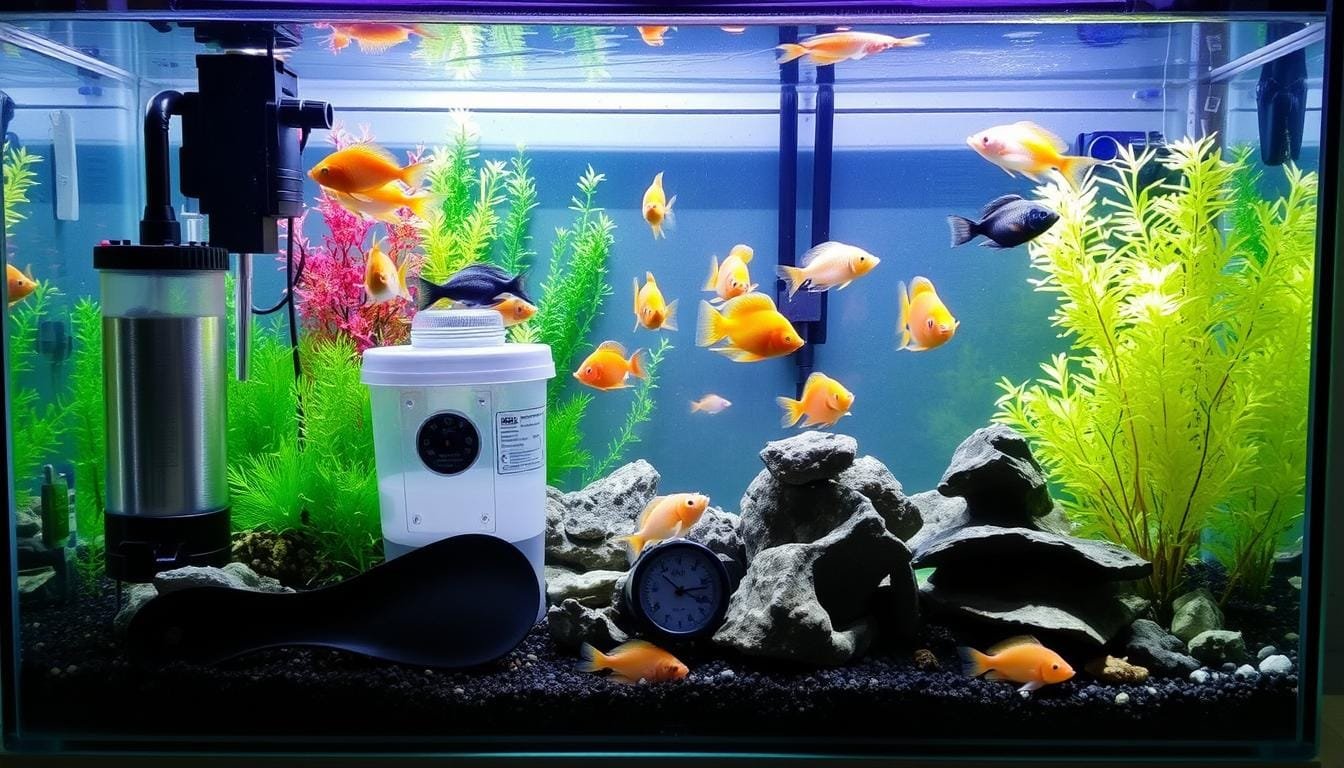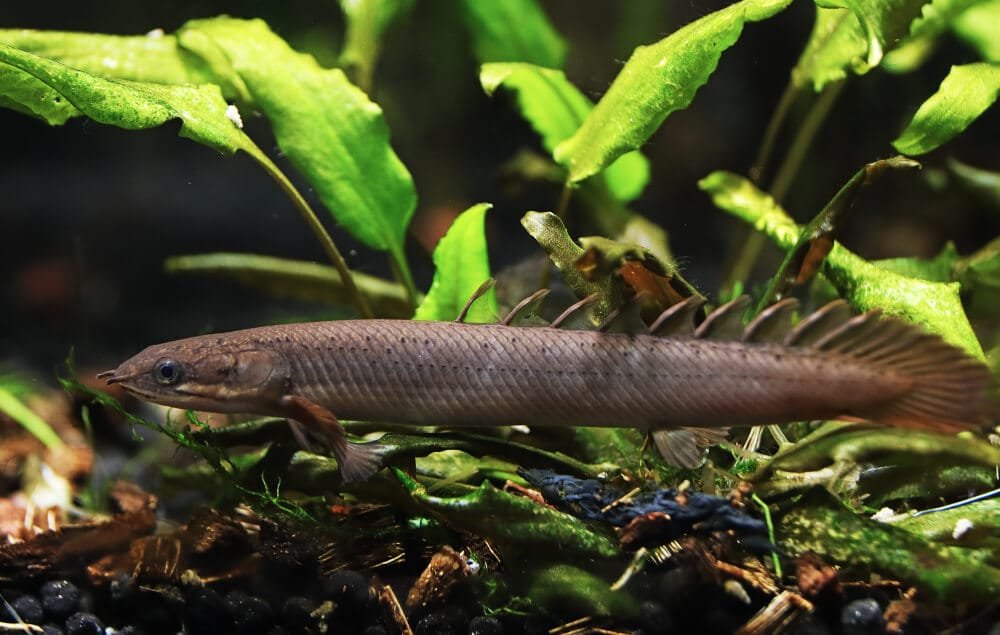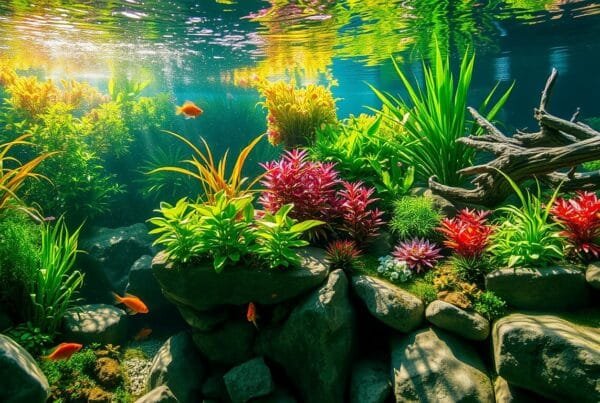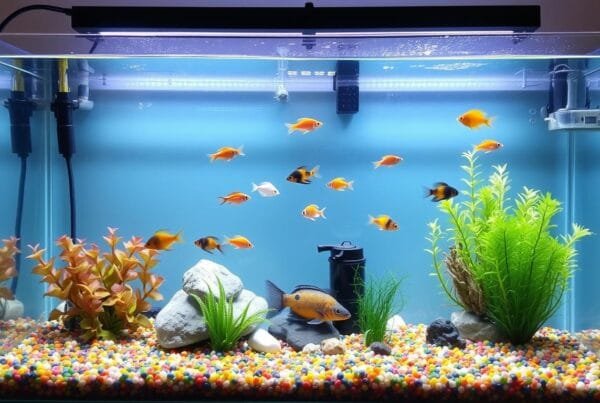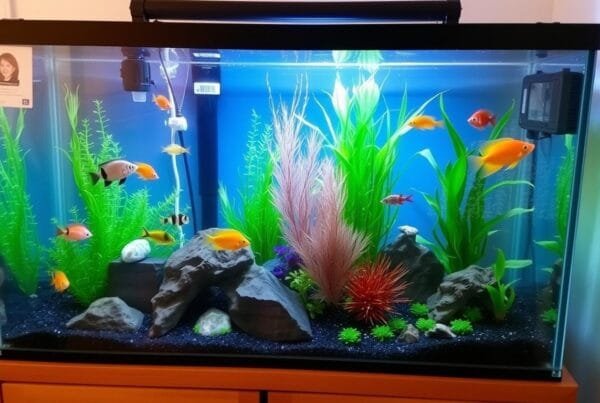Did you know 12 million households in the U.S. have an aquarium? Setting up your first tank can turn your home into a colorful underwater world. Choosing the right equipment is key to a thriving aquatic environment.
Starting your aquarium journey needs careful planning and the right tools. The foundation of a successful tank includes understanding the aquarium tank, filter, heater, and lighting. Each piece is vital for a healthy home for your fish.
For beginners, the world of fish keeping can seem overwhelming. Choosing the right setup is simpler than it seems. Focus on the essential equipment for a stable and comfortable home for your fish.
Modern aquarium technology makes creating a stunning underwater habitat easy. You’ll find advanced filtration systems and energy-efficient LED lighting. The goal is to find a balance between what looks good and what your fish needs.
Whether you want a small betta tank or a big community aquarium, knowing the basics is essential. We’ll show you the must-have supplies to turn your aquarium into a thriving underwater world.
Understanding Basic Aquarium Requirements
Setting up an aquarium needs careful planning. You must think about the tank size, material, and where it goes. These choices greatly affect your fish’s health and the tank’s overall health.
Why Tank Size Matters
The tank size is key for your fish’s health and the tank’s balance. Experts suggest the following:
- Minimum tank size for freshwater fish: 16 gallons
- Betta fish minimum tank size: 5 gallons
- Weight consideration: About 10 pounds per gallon of water
Glass vs. Acrylic Tanks
Choosing between glass and acrylic tanks has its pros and cons:
| Glass Tanks | Acrylic Tanks |
|---|---|
| More scratch-resistant | Lightweight and more impact-resistant |
| Less expensive | Better insulation properties |
| Heavier | More expensive |
Tank Location and Support Considerations
Finding the perfect spot for your tank is vital. A sturdy, level surface that can support the tank’s weight is essential. Think about these points:
- Proximity to electrical outlets
- Away from direct sunlight
- Stable, flat surface
- Easy access for maintenance
“The right location can make or break your aquarium experience.” – Aquarium Enthuasiast Magazine
Remember, a small aquarium can weigh almost 95 kilograms when full. So, get a high-quality aquarium stand made for your tank’s size and weight.
Essential Aquarium Equipment to Get Started
Setting up an aquarium needs careful choice of key equipment. Each piece is vital for your underwater world’s health and balance.
- Filter: The cornerstone of water quality management
- Heater: Maintaining consistent water temperature
- Thermometer: Monitoring temperature accurately
- Substrate: Providing foundation and biological support
- Air pump: Ensuring proper water circulation
Choosing a filter is key. Experts say pick one that can handle at least double your tank’s size. For example, a 20-gallon tank needs a filter for 40 gallons. Internal and hang-on-back (HOB) filters are best for smaller to medium-sized tanks.
“A well-equipped aquarium is a balanced ecosystem, not just a glass box with water.”
Keeping the water temperature right is important. Aim for 5 watts per gallon to warm the water about 10°F above room temperature. A tip: Use two smaller heaters for better safety and heat spread.
Choosing the right substrate is also key. Pool Filter Sand is a good, cheaper option than aquarium sand. For plants, use 2-3 inches of substrate to help roots and bacteria grow.
Remember: Investing in the right equipment means a healthy, lively aquarium ecosystem.
Filtration Systems: The Heart of Your Aquarium
Aquarium filters are vital for a healthy fish tank. They keep the water clean by removing harmful stuff. Knowing the three main types of filtration is key for a thriving tank.
A good aquarium filter uses different methods to keep your tank clean. Let’s look at the main parts that help your aquatic world stay healthy.
Mechanical Filtration Methods
Mechanical filtration is the first step in cleaning the water. It removes solid waste and particles. The main parts are:
- Filter floss
- Sponge materials
- Filter pads
The AquaClear Power Filter is great for mechanical filtration. It can handle up to 200 gallons per hour for tanks up to 50 gallons.
Chemical Filtration Components
Chemical filtration gets rid of dissolved impurities and smells. Activated carbon is the main tool for this. It removes:
- Discoloration
- Medications
- Organic compounds
Experts say to change activated carbon every month. This keeps the water quality high.
Biological Filtration Importance
Biological filtration is vital for a balanced tank. It uses good bacteria to turn harmful ammonia into safer nitrates.
The nitrogen cycle is the backbone of a healthy aquarium, transforming potentially deadly ammonia into safer nitrates.
| Filter Type | Tank Size | Flow Rate (GPH) |
|---|---|---|
| Sponge Filter | Up to 20 gallons | 20-40 |
| Hang-on-Back Filter | 20-50 gallons | 80-150 |
| Canister Filter | 50-250 gallons | 200-700 |
Pro tip: When picking a filter, go for one that can cycle your tank volume 4-6 times per hour for the best water quality.
Water Temperature Control Equipment

Keeping the water temperature stable is key for your aquarium’s health. An aquarium heater is essential for both tropical and coldwater fish. The best temperature is usually between 75-80 degrees Fahrenheit, which most fish like.
Choosing the right heater involves a few important steps. The wattage needed is about 3-5 watts per gallon of water. Experts say to think about your tank size and the fish you when picking a heater.
- Submersible heaters: Most common type with precise temperature control
- Hang-on heaters: More affordable but less efficient
- In-line heaters: Best for large tanks, requires additional plumbing
- Heating cables: Ideal for promoting plant root growth
Different fish need different temperatures. Tropical fish like warmer water, while coldwater fish prefer cooler. A good thermometer is key for keeping the temperature right.
| Heater Type | Efficiency | Cost Range |
|---|---|---|
| Submersible Heaters | High | $$ |
| Hang-on Heaters | Medium | $ |
| In-line Heaters | Very High | $$$ |
Pro tip: Check your aquarium heater regularly for wear and water damage to keep the temperature steady.
Think about where you put your tank. Stay away from heating vents, sunny windows, and drafty spots. Many heaters have thermostats that keep the water at the right temperature, making things easier for you.
Lighting Solutions for Aquarium Success
Aquarium lighting does more than just light up the space. It’s key to a thriving underwater world. It helps plants grow and makes your aquarium look amazing.
Today’s aquarium lighting is a big leap forward. LED lights are a top choice because they save a lot of energy. They use up to 80% less power than old lights.
Types of Aquarium Lighting
- LED Lighting: Energy-efficient and long-lasting
- Fluorescent Lights: Affordable and widely used
- Metal Halide Systems: High-intensity option for deep tanks
- Compact Fluorescent: Space-saving and powerful
Lighting Requirements for Different Setups
Every aquarium is different. Reef tanks need special light colors. Planted tanks need light that helps plants grow.
Pro Tip: Aim for 1-2 watts of lighting per gallon of water for optimal results.
Timer and Light Control Systems
Light timers make caring for your aquarium easier. They mimic day and night, helping plants grow up to 30% more.
| Lighting Type | Energy Efficiency | Plant Growth Impact |
|---|---|---|
| LED | 80% reduction | High |
| Fluorescent | Moderate | Moderate |
| Metal Halide | Low | High |
Choosing the right lighting is important. Think about your tank’s size, the fish and plants, and what you want to achieve. Good lighting and control systems keep your aquarium healthy and beautiful.
Substrate Selection and Installation
Choosing the right aquarium substrate is key for a healthy underwater world. It supports beneficial bacteria and plant growth, not just looks.
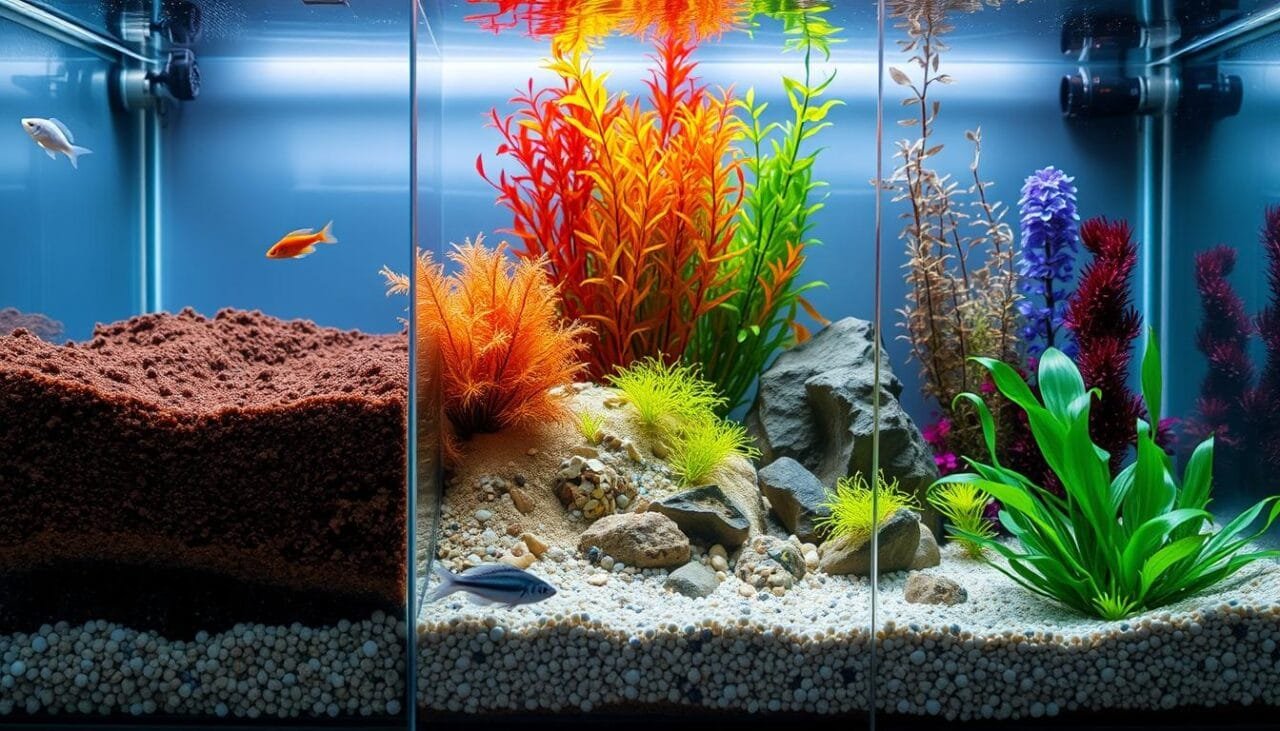
- Gravel: Most common and versatile substrate option
- Sand: Smooth texture ideal for certain fish species
- Plant substrate: Nutrient-rich medium for aquatic vegetation
“The right substrate can transform your aquarium from a simple container to a living ecosystem.”
When picking a substrate, think about these important factors:
- Tank inhabitants’ specific needs
- Plant requirements
- Water chemistry compatibility
| Substrate Type | Pros | Cons |
|---|---|---|
| Gravel | Easy to clean, good water circulation | Limited nutrient retention |
| Sand | Natural look, good for bottom-dwelling fish | Can compact, challenging root penetration |
| Specialized Plant Substrate | Rich in nutrients, supports plant growth | More expensive, requires replacement |
For substrate installation, aim for a gradual depth gradient of 2-3 inches. Rinse the substrate well before adding it to your tank. This removes dust and debris. Root tabs can help with nutrient-poor substrates, promoting plant health.
Expert tip: Mixing substrates can improve water and plant nutrition. Blend different types for the best environment for your aquatic ecosystem.
Water Quality Management Tools
Keeping water quality right is key for a healthy aquarium. Experts know that managing water well needs special tools and regular checks. Aquarium water testing gives important info about your tank’s health.
Essential Test Kits for Aquarium Health
Water test kits are vital for tracking important factors that affect fish health. These tools help owners check key water chemistry elements:
- pH meter for measuring acidity levels
- Ammonia test strips
- Nitrite and nitrate detection kits
- Water hardness assessment tools
Water Conditioners and Treatments
Water conditioners are key for a safe aquarium. They help:
- Remove harmful chlorine and heavy metals
- Introduce beneficial bacteria
- Stabilize water chemistry
- Reduce stress on aquatic inhabitants
Maintenance Equipment Essentials
Good aquarium care needs specific tools for water quality and tank cleanliness. Here’s a list of must-haves:
| Equipment | Purpose | Frequency of Use |
|---|---|---|
| Siphon | Water changes and substrate cleaning | Bi-weekly |
| Gravel Vacuum | Remove debris and waste | Weekly |
| Algae Scraper | Clean tank walls | As needed |
Professional tip: Do monthly water quality tests to keep your aquarium healthy.
Remember, regular checks and upkeep are essential for a thriving aquarium.
Air Supply and Circulation Systems
Keeping your aquarium healthy needs good air supply and water flow. An air pump is key to keeping your water full of oxygen.

- They increase oxygen in the water
- Stop water from getting stale
- Make sure water moves well
- Help good bacteria grow
When picking air circulation gear, think about these important parts:
| Equipment | Primary Function | Best For |
|---|---|---|
| Air Pump | Make air flow | All tank sizes |
| Air Stone | Make fine bubbles | Boost oxygen levels |
| Bubble Wand | Spread bubbles out | Bigger tanks |
| Powerhead | Improve water flow | Stop dead spots |
*Proper air circulation is the breath of life for your aquarium ecosystem.*
The right mix of air pump, air stone, and powerhead can make your tank healthier. Putting them in the right spots helps oxygen spread and water move well. This makes a great home for your fish and plants.
Decorative Elements and Aquascaping Basics
Creating a stunning aquascape is more than just filling a tank with water. Aquarium decorations turn an ordinary tank into a breathtaking underwater world. Rocks, driftwood, and plants are key to bringing life and character to your aquatic space.
When picking aquarium decorations, think about how they look and their benefits. Natural items like rocks and driftwood offer hiding spots for fish and add visual interest.
- Rocks: Provide structure and natural terrain
- Driftwood: Creates depth and organic texture
- Plants: Add color and biological filtration
- Artificial ornaments: Personalize your aquascape
The key to a successful aquascape is balance between natural elements and strategic design.
Different aquascaping styles offer unique ways to design your tank. Some like the simple Iwagumi layouts, while others prefer lush, jungle-like scenes.
| Aquascaping Style | Key Characteristics |
|---|---|
| Dutch Style | Emphasizes colorful plant arrangements |
| Nature Aquarium | Mimics natural landscapes with precise composition |
| Iwagumi | Minimalist design focused on stone placement |
Make sure to prepare your decorative elements well. Clean rocks and driftwood thoroughly. Proper preparation prevents water quality issues and protects your fish.
Tank Maintenance Equipment
Keeping an aquarium clean and healthy needs the right tools and a regular maintenance routine. Effective aquarium cleaning requires special equipment and strategies.
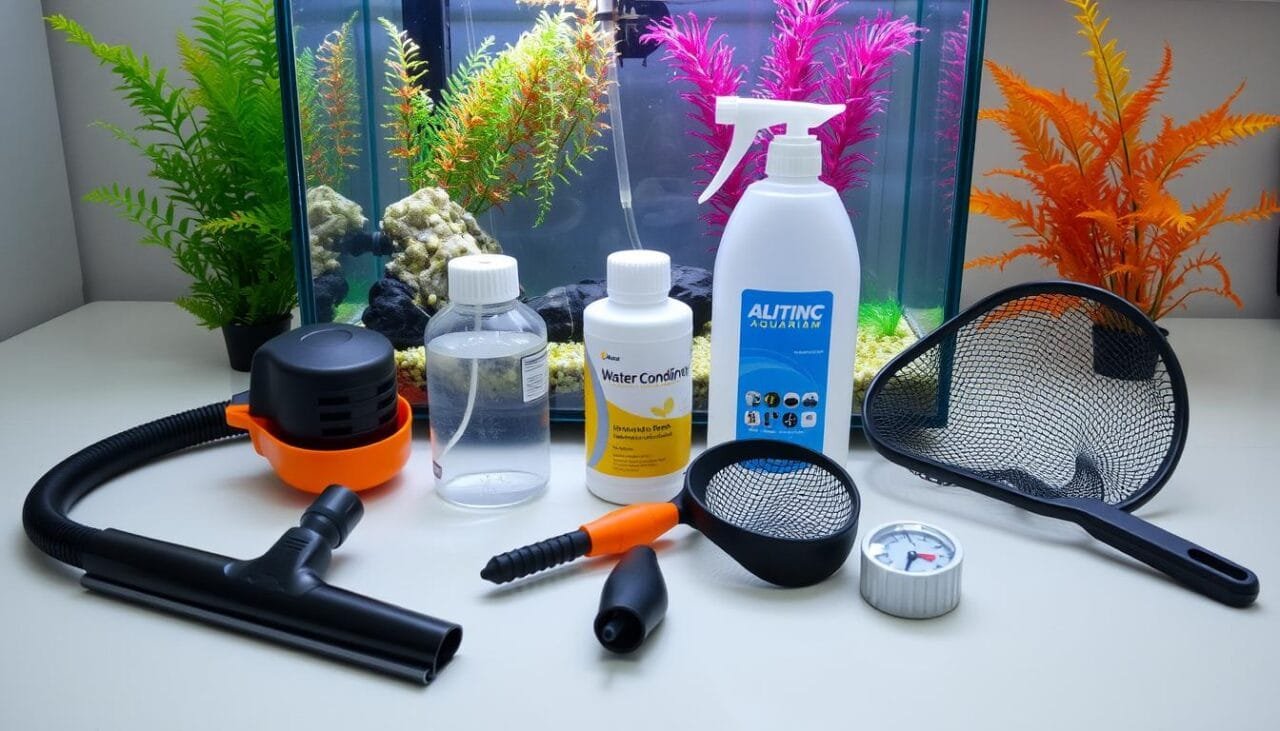
Essential Cleaning Tools and Supplies
Every aquarium owner needs specific cleaning tools. These tools help keep water quality and fish health good. The must-haves include:
- Siphon for water changes
- Gravel vacuum to remove debris
- Algae scraper for glass cleaning
- Fish net for safe fish handling
- Bucket for water collection
Water Change Equipment
Water changes are key for aquarium care. They should be 20-30% every two weeks. Important equipment for water changes includes:
| Equipment | Purpose |
|---|---|
| Gravel Vacuum | Remove waste and debris from substrate |
| Water Conditioner | Neutralize harmful chemicals during water change |
| Thermometer | Ensure consistent water temperature |
Regular Maintenance Checklist
A regular maintenance routine is vital. Consistency is key in aquarium care.
- Daily: Check fish behavior and equipment functioning
- Weekly: Clean glass, check water parameters
- Bi-weekly: Perform partial water change
- Monthly: Deep clean filter, inspect equipment
Remember, a well-maintained aquarium is a healthy ecosystem for your aquatic friends.
Conclusion
Creating a thriving aquarium needs careful planning and consistent care. It’s more than a hobby; it’s a commitment to an underwater world. A good aquarium setup means choosing the right parts, keeping water clean, and creating a home for aquatic life.
Studies say a 20-gallon tank is best for beginners. Regular water changes of 20-30% every two weeks help a lot. Good filtration and temperature control also boost your tank’s health. Quality equipment might cost more, but it’s worth it for your fish’s health.
Success in aquarium keeping comes from learning and caring every day. Keep an eye on water quality and watch for stressed fish. With patience and effort, your aquarium can become a beautiful, peaceful part of your home. Every expert started where you are, with curiosity and a love for fish.
FAQ
What is the most important piece of equipment for a new aquarium?
The filter is key for any new aquarium. It keeps the water clean by removing waste. It also supports beneficial bacteria, keeping your tank healthy and stable.
How do I choose the right size tank for beginners?
Beginners should start with a 20-30 gallon tank. Larger tanks are easier to care for. They offer more stable water conditions and room for mistakes.
Do I really need a heater for my aquarium?
Yes, most aquariums need a heater, even in rooms with steady temperatures. A heater keeps the water at 75-80°F, which is best for tropical fish.
How often should I test my aquarium water?
New aquariums need water tests weekly. Once your tank is stable, you can test every 2-4 weeks. This depends on your tank’s health and fish number.
What type of substrate is best for a beginner aquarium?
Gravel is great for beginners. It’s easy to clean and comes in many colors. For planted tanks, use specialized substrates.
How important is lighting in an aquarium?
Lighting is very important, more so for planted tanks. LED lights are best for beginners. They save energy, produce less heat, and have day-night settings.
Do I need an air pump for my aquarium?
Air pumps are not always needed but are helpful. They increase oxygen and water movement. They’re good for tanks with little surface activity or for fish that need lots of oxygen.
How many fish can I put in my new tank?
Start with one inch of fish per gallon for small fish. But, this depends on the fish type, tank setup, and filtration. Always check the fish’s specific needs.
What maintenance equipment do I need?
You’ll need a siphon, gravel vacuum, water test kit, algae scraper, bucket, and fish net. These tools help with water changes and keeping your tank clean.
How often should I do water changes?
Do 10-25% water changes every 1-2 weeks for most tanks. This removes waste and keeps water quality up. New tanks might need more frequent changes during the first few weeks.
